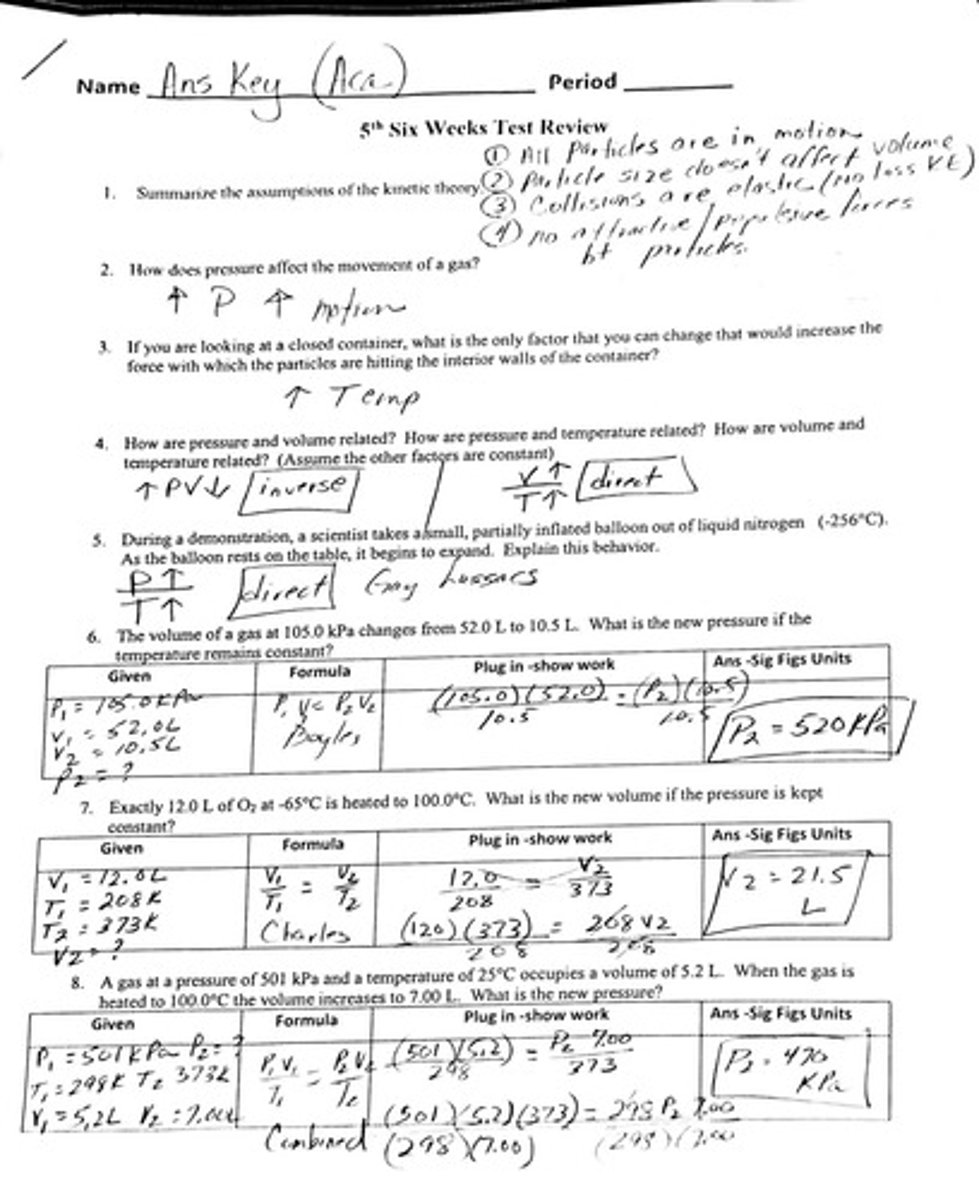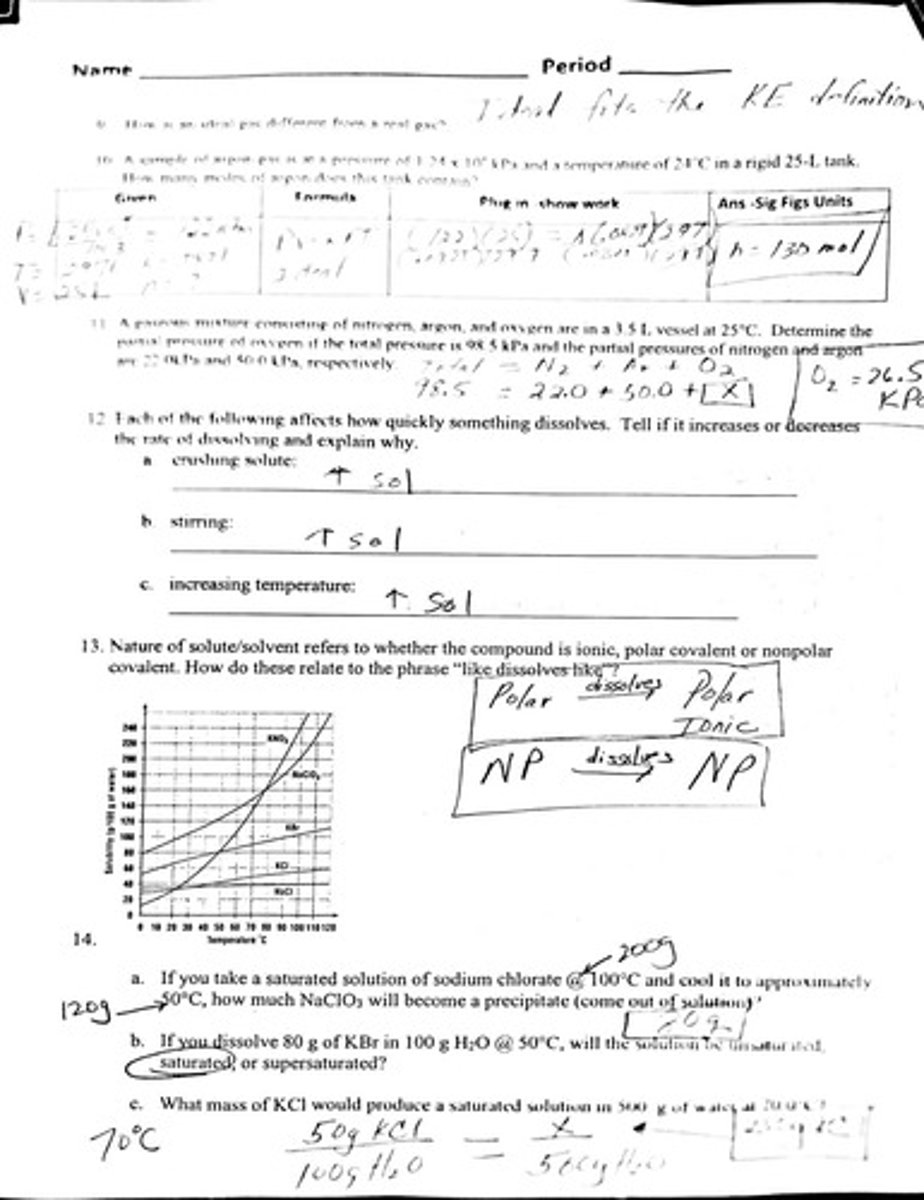Gas Laws and Solution Chemistry Review
1/24
There's no tags or description
Looks like no tags are added yet.
Name | Mastery | Learn | Test | Matching | Spaced |
|---|
No study sessions yet.
25 Terms
What are the main assumptions of the kinetic theory of gases?
1. All particles are in motion. 2. Particle size does not affect volume. 3. Collisions between particles are elastic (no loss of kinetic energy). 4. There are no attractive or repulsive forces between particles.

How are pressure and volume related in a gas?
Pressure and volume are inversely related (as one increases, the other decreases).
How many moles of argon are in a 25-L tank at 124 kPa and 24°C?
Using the ideal gas law, there are approximately 11.0 moles of argon.
How much stock solution is needed to prepare 300.0 mL of a 0.750 M NaBr solution from a 2.00 M stock solution?
You need 112.5 mL of the stock solution.
How does pressure affect the movement of a gas?
Increasing pressure increases the motion of gas particles.
How do ideal gases differ from real gases?
Ideal gases follow gas laws perfectly without deviations, while real gases exhibit interactions and occupy volume.

What is the difference between saturated, unsaturated, and supersaturated solutions?
Saturated solutions contain the maximum amount of solute at a given temperature, unsaturated solutions can dissolve more solute, and supersaturated solutions contain more solute than can typically be dissolved at that temperature.
What factors affect the solubility of gas and solid solutes in a solution?
Increasing temperature generally increases the solubility of solids, while it decreases the solubility of gases.
What factor can you change in a closed container to increase the force with which gas particles hit the walls?
Increasing the temperature.
How are pressure and temperature related in a gas?
Pressure and temperature are directly related (as one increases, the other increases).
How are volume and temperature related in a gas?
Volume and temperature are directly related (as one increases, the other increases).
What happens to a partially inflated balloon taken out of liquid nitrogen as it warms up?
The balloon expands as the temperature increases.
What is the formula used to calculate the new pressure of a gas when its volume changes at constant temperature?
P₁V₁ = P₂V₂ (Boyle's Law).
If the volume of a gas at 105.0 kPa changes from 52.0 L to 10.5 L, what is the new pressure?
Using the formula P₁V₁ = P₂V₂, the new pressure is 520 kPa.
What is the new volume of a gas at -65°C heated to 100.0°C at constant pressure?
Using Charles's Law, the new volume is 21.5 L.
What is the new pressure of a gas at 501 kPa and 25°C when heated to 100.0°C and the volume increases to 7.00 L?
The new pressure is 470 kPa.
What is the partial pressure of oxygen in a mixture of gases with a total pressure of 98.5 kPa?
The partial pressure of oxygen is 26.5 kPa (98.5 - 22.0 - 50.0).
What factors affect how quickly a solute dissolves?
Crushing the solute increases the rate of dissolving, and increasing temperature also increases the rate.
What does 'like dissolves like' mean in terms of solubility?
Polar solutes dissolve in polar solvents, ionic solutes dissolve in polar solvents, and nonpolar solutes dissolve in nonpolar solvents.
What mass of KCl would produce a saturated solution in 500 g of water at 70.0°C?
Approximately 50 g of KCl would produce a saturated solution at this temperature.
How many moles of solute are in 7500 mL of a 1.50 M solution?
There are 11.25 moles of solute.
What is the molarity of a solution containing 212.5 g of NaNO3 in 300.0 mL?
The molarity is approximately 4.00 M.
What are the spectator ions in a double replacement reaction?
Spectator ions are ions that do not participate in the reaction and remain unchanged.
Write the complete ionic equation for the reaction of magnesium sulfate and calcium nitrate.
MgSO₄ + Ca(NO₃)₂ → Mg²⁺ + SO₄²⁻ + Ca²⁺ + 2NO₃⁻.
Still learning (8)
You've started learning these terms. Keep it up!